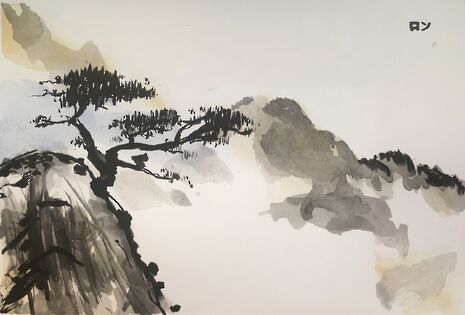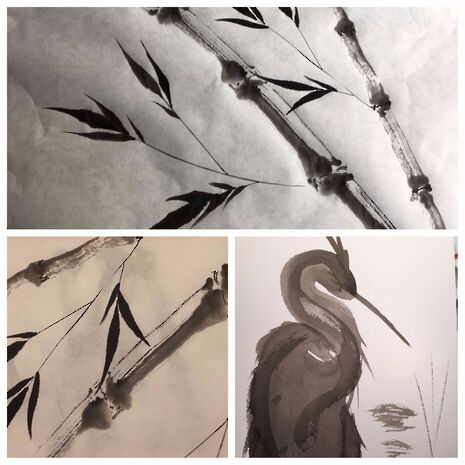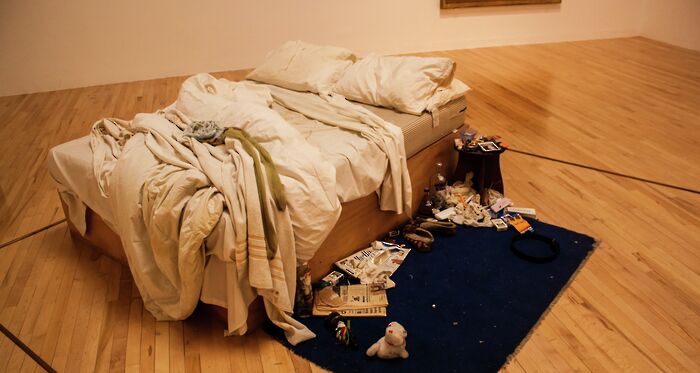How I learnt to stop worrying and love the art of sumi-e
Spencer Cunningham takes us through his often tortuous, though always worthwhile, experience learning the art of sumi-e

I have always wondered what it would be like to be an artist. For most of my life, this was an idle daydream. It took me an embarrassingly long time as a child to understand that the legs and arms of my stick figures were not supposed to come directly out of their heads, and afterwards, I avoided all visual arts education as a matter of principle.
But I was always secretly attracted to the beret, the oblong palette with the little thumb hole, Venetian sunrises, etc. Usually, I was content to smile about these ideas and continue with my day, but about a year ago, that changed. I came across a haunting, multi-panelled ink-wash landscape in the Japanese wing of New York’s Metropolitan Museum of Art. The black mountains and pines on the paper screen faded away into mist. I marvelled at the delicacy of their execution, the simplicity of the palette, the streaks of grey and black that hinted at forms, and the casual, almost improvisational style of the brush stroke. I decided I would learn sumi-e.
“The idea that whatever came off my brush could be valuable because of its connection to a unique moment of action was strangely enthralling”
There was once a time when this kind of impulse would have been difficult to realise. I might have nursed the idea for a bit and then forgotten about it after something more pressing came along. Not so with the internet. In a matter of minutes, without even properly considering it, I ordered the materials, found a legion of YouTube instructors, and uncovered more information than I could ever read on the subject. I learned, from the comfort of a bedroom, how to hold the brush, grind the ink from the ashen pigment stick, dilute it with water, and layer different shades onto the brush so that one stroke would produce a spectrum of greys. I researched types of specially textured paper and the history and philosophy of the ink wash tradition – all before the equipment arrived.

The foundational subject of sumi-e, I learned, is bamboo. Producing the plant’s stalk and leaves requires delicate brush techniques. It is the discipline’s training ground: relatively easy to paint adequately but allowing for limitless improvement. This is where I decided to start. After my materials arrived, I selected a video. The instructor mixed her ink to just the right shade, and I followed along. She drew her hand across the paper. The bamboo leaves seemed to spring fully alive from her brush. A single stroke produced a single leaf, always effortlessly. They bent and twisted in an imagined wind. The composition, with its generous use of blank space, seemed both accidental and harmonious.
I attempted to follow along. My first leaf emerged as a formless blob. I tried again. This time it was another misbegotten mass that bled into its neighbour. I put the paper aside and got another sheet. By the time I looked up again, my room was filled with wet sheets of paper, each with amorphous smears of ink. I felt like Dr Rorschach’s unpaid intern, and in the dark blots, I saw frustration. Confound the internet for making me do this!
But for some reason I didn’t stop. Something about the simplicity of the medium kept me going. They were just bamboo leaves, after all. And there was only one colour to paint with: black. The task was clear. I was drawn into the great paradox of sumi-e; the simplest materials and subjects created the subtlest challenges. Over time, I improved – not rapidly, not even much at all, but I began to take an unexpected joy in my artistic mediocrity. Every minor improvement was satisfying. The knowledge that I would never actually be that good at sumi-e meant that I was free from any hunger for recognition. A pursuit that began as an attempt to vindicate my idle dreams of artistry became a case of simply doing something I enjoyed. The latter was much more rewarding.
Sumi-e privileges spontaneity and impression. It requires suggestion rather than exhaustive detail. As a university student, I had come to view my work, mostly writing, as an almost endless series of edits and refinements, deletions and insertions. The idea that whatever came off my brush could be valuable because of its connection to a unique moment of action was strangely enthralling. I would sometimes try to insert my obsessiveness into the process, but each effort to alter the original brushstrokes made the painting worse. Despite my best efforts, I had to be natural, to live happily with the flow of ink and water on paper.
Our world is dominated by a professional system where we are made to choose one thing we can do well and jettison the rest. Much of this newspaper’s readership participates in a rarefied subsection of that world that is concerned with its own conception of excellence and distinction. But specialisation can be stultifying. Vocations can weigh heavy. There is, I think, room for amateurism, for folly. It can inform the more focused parts of our lives in unexpected ways, and even if it doesn’t, it carries us briefly from our small spheres of proficiency to a wider world of unknowable complexity and talent. So let’s try something new, and if at all possible, let’s be unremarkable at it
 News / SU reluctantly registers controversial women’s soc18 December 2025
News / SU reluctantly registers controversial women’s soc18 December 2025 News / CUP announces funding scheme for under-represented academics19 December 2025
News / CUP announces funding scheme for under-represented academics19 December 2025 Features / Should I stay or should I go? Cambridge students and alumni reflect on how their memories stay with them15 December 2025
Features / Should I stay or should I go? Cambridge students and alumni reflect on how their memories stay with them15 December 2025 Fashion / The art of the formal outfit 18 December 2025
Fashion / The art of the formal outfit 18 December 2025 News / Dons warn PM about Vet School closure16 December 2025
News / Dons warn PM about Vet School closure16 December 2025










